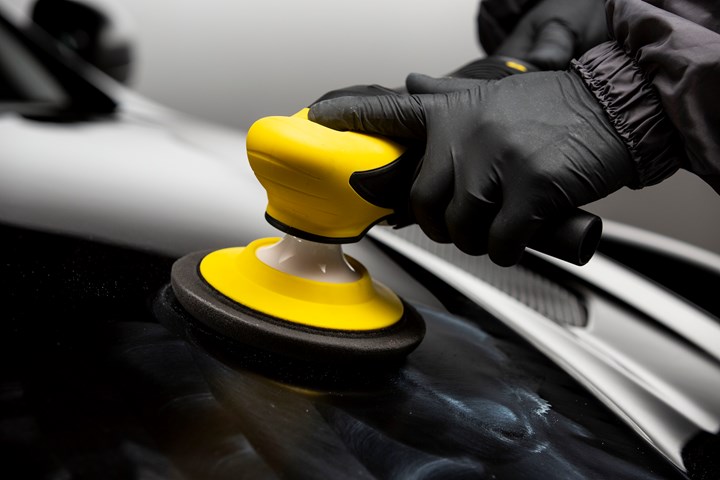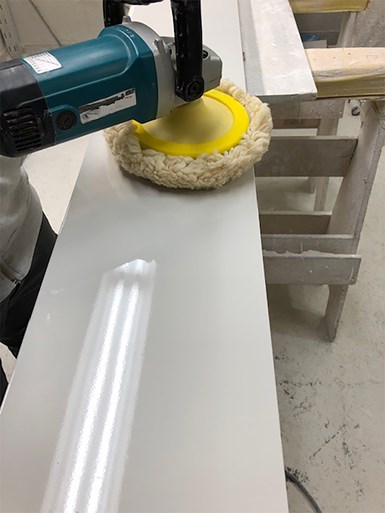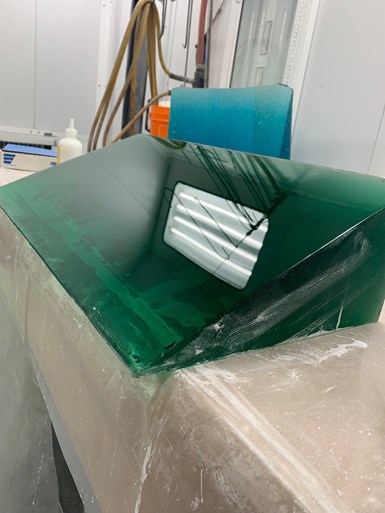
Compound with a G-Mop 6in Flexible Black Finishing Foam Pad
Photo Credit: Norton | Saint-Gobain Abrasives
Whether it is in the automotive or marine spaces, or for kitchen cabinetry, furniture or architectural displays, high gloss finishes are sought after. It is the right abrasive compound that enables the manufacturer, artisan or cabinet maker’s pieces to finish with flawless perfection.
Successful polishing for prime automotive
In the prime automotive space, the manufacturing production lines are producing hundreds or even thousands of vehicles daily so teams of skilled workers are tasked with addressing even the smallest flaws, to avoid scratches, spots, or other markings that make for a dull finish. Once they are spotted, the team can get to work on addressing them through sanding and buffing.
To avoid damage to the finish, only a few seconds of sanding can be allowed. It is during the buffing stage that a surface finishing system incorporating Farécla compounds and pads can be used together to proactively address the more challenging aspects of the polishing process: the rate at which end products need to be completed to keep pace with demand, also known as takt time; the effectiveness of materials; and overall cost, particularly in terms of the number of pads expended.
One baseline benchmark for prime automotive is keeping per-unit takt time under one minute — in other words, no more than a minute spent by the team on a single car. That is an ambitious goal that can only be met by highly skilled workers and finishing systems tuned for speed and efficiency. Farécla system testing has consistently shown an ability to meet or exceed the one-minute per vehicle takt time goal. Less time needed for buffing allows operators more time to thoroughly inspect and complete their work. It also affords operators more time to rest between vehicles, creating an ergonomic advantage with a significant positive impact on productivity. The overall net result is that labor hours are cut in half.
Many buffing compounds include petroleum-distillate fillers and silicones that provide a “quick fix” for surfaces, with less abrasion. Farécla compounds, by contrast, contain no fillers or silicones and, as water-based products, are easy to clean up. Each spot to be buffed requires just a pea-sized amount, resulting in cost savings. Their semi-transparent nature also offers a more viewable work area, with greater potential for gauging the success of defect removal. In prime automotive settings, this can be demonstrated by wiping down the buffed area with alcohol, underscoring their qualification within the preferred product class of “what you see is what you get.”

Buffing cabinetry topcoats can remove imperfections introduced during the coating application.
Photo Credit: Norton | Saint Gobain Abrasives
Cabinetry — it’s all about the topcoat
In the cabinetry industry, today’s coatings are usually two-pack polyurethane clear coats and paints. Two-pack means the paint is mixed with a catalyst to promote a cross-linked cure. This accelerates drying times and creates a harder, more durable surface, compared to the old lacquer, air dry varnishes you had on Gramma’s rocker. And, while cabinetry wood is not buffed, the topcoat that is applied to the wood is.
During the coating application, various defects or imperfections, such as dust nibs, runs and orange peel can mar the finish, reducing the eye appeal. With the use of fine abrasive papers such as P1200 and P1500 grit, these defects are removed. Dust nibs and orange peel are easily sanded out using a palm sander and a Norton Q175 P1500 grit film disc. Runs may need to be blocked out with coarser grits before a final sand with the P1500 film disc.
Farécla compounds can stop the sanding process at P1500 avoiding costly re-works, where many other conventional compounds require additional sanding steps with P2000 and P3000 grits. These sanding abrasives are very expensive. Farécla compounds can quickly and easily remove the P1500 sand scratch. The innovative abrasive design in the compounds does not diminish to any significant degree, and thus stays sharper longer giving rise to a faster initial cut while maintaining an excellent finish.
For example, used with a Farécla 100% 4ply twisted wool pad attached to a polisher, a small amount of Farécla Profile Advanced Plus compound about the size of a quarter can be applied to the cabinetry panel. It is recommended to gently pump the trigger of the polisher on a low speed to spread the compound over the area to be buffed. Once it is evenly spread, turn up the machine to an operating speed between 1100 and 1500 rpm. With light pressure and the wool pad held flat against the surface, move the polisher slowly over the sand scratches. In use, the compound becomes almost transparent, so the operator can actually see the sand scratches being removed. Once the sanding scratches have been removed, wipe with a microfiber cloth.
In addition to achieving a much higher gloss level, the benefits of Farécla Advanced Plus include cost savings from using less compound and shortened cycle times because of a faster cut-rate. Also, the compound is water-based, making for easier and quicker clean-up.

Sanded and buffed correcly, polyester resin can yield a high gloss finish.
Photo Credit: Norton | Saint-Gobain Abrasives
Polishing resins
Resin surfaces such as cultured marble, molded polyester objects, and gelcoats (often used to coat fiber-reinforced composite structures), can be polished for a high gloss finish.
Take, for example, a polyester pour is used as a retail display accent.
Polyester resin is mixed with various catalysts and a transparent pigment and is poured into a block mold. Once it is cured (hardened), it is milled to the desired shape using a CNC machine. This leaves the surface with a rough finish ready to be sanded. The sanding process is quite extensive, starting at P80 grit and moving finer to P120-P220-P320-P400-P600-P800-P1200 and finally, P1500. Each grit removes previous scratch marks.
As with the cabinetry example, to buff the polyester resin and remove the scratches, it is recommended to use a Farécla 100% 4ply twisted wool pad, attach it to a polisher, and apply a small amount of Farécla Profile Advanced Plus Compound about the size of a quarter is applied to the surface. Gently pump the trigger of the polisher on a low speed to spread the compound over the area to be buffed. Once evenly spread, turn up the machine to an operating speed between 1100 and 1500 rpm. With light pressure and the wool pad held flat against the surface, move the polisher slowly over the sand scratches. Reapply and repeat until the panel is complete. In use, the compound becomes almost transparent so the operator can actually see the sand scratches being removed. Once the sanding scratches have been removed, wipe with a microfiber cloth.
Gary Fields, a composite specialist at The Paragon Innovation Group INC. with many years’ experience of polishing different substrates from polyester, urethane epoxy and plastics of various hardness, claims, “The vast selection of Farécla products address my needs in a fast, efficient process with optimum gloss.”
A multitude of surfaces
Today’s ever-changing design trends have taken the quest for a high gloss finish into items used every day and the finish expectations are the same. From cars to boats to kitchen cabinets, the goal is to draw attention. Careful research when choosing a compound system can help with this process by providing the highest level of shine on both painted and gel-coated surfaces.
Related Content
Blasting Beads Made of Lead-Free Natron Glass
SwarcoBlast blasting media are made for use in a multitude of surface refinement applications.
Read MoreRobot-Ready Grinding Systems for High-Speed Production
Advanced rotary surface grinders now come “robot-ready” to facilitate integration with third party robotic arms and fully automate the process from loading to unloading.
Read MoreEngineered Shaped Grain Abrasives Take Grinding Productivity to New Heights
Unique three-pointed curved grain approach offers advantages for tough grinding applications.
Read MoreLapping, Polishing Film Maximizes Strengths, Maintains Flexibility
Dia-Strip and Dia-Sheet film from Titan Tool Supply has a distinct construction that the company says makes it durable while remaining flexible, bendable and formable.
Read MoreRead Next
Delivering Increased Benefits to Greenhouse Films
Baystar's Borstar technology is helping customers deliver better, more reliable production methods to greenhouse agriculture.
Read MoreEducation Bringing Cleaning to Machining
Debuting new speakers and cleaning technology content during this half-day workshop co-located with IMTS 2024.
Read MoreA ‘Clean’ Agenda Offers Unique Presentations in Chicago
The 2024 Parts Cleaning Conference, co-located with the International Manufacturing Technology Show, includes presentations by several speakers who are new to the conference and topics that have not been covered in past editions of this event.
Read More












.jpg;maxWidth=300;quality=90)









